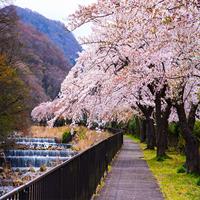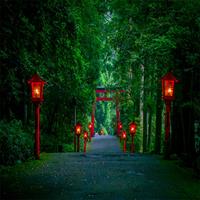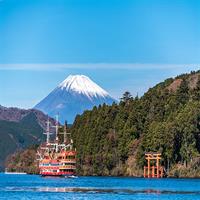Day 1 in Hakone
Welcome to Hakone! Upon arrival at the airport, you will go through customs and immigration. Should you opt to purchase a transfer to your hotel; a representative will be waiting for you as you exit immigration. Arrive at your hotel, check in and do not give in to jet lag! There is so much for you to see and do!
We recommend you get acquainted with the city, take a pleasant stroll around the stunning Lake Ashi, which will lead you to the grand Torii gate and the Hakone Shrine. The shrine is a rather magical and atmospheric place set in an impressive old forest on the shores of Lake Ashi. Walk along the lantern-line path and through the forest to the red `Peace` torii gate which floats in the lake waters.
There is a small museum on-site which displays several of the shrine`s treasures including five items ranked as National Important Cultural Property. Wander around the museum, shrine, and scenic grounds.
There is a hiking trail along the old Tokaido Road, which once linked five main highways from Tokyo and Kyoto during the Edo Period. There is a pleasant hike that will take you along the remains of a section of the old road where the original stone pavement still stands. Parts of the hiking path are flanked by massive cedar trees that are centuries old, some reaching up to 10 feet tall with a diameter of 13 feet.
The Hakone Checkpoint is a place filled with Japanese history, there are an exhibition hall, foot soldier housing, and a prison chamber. Be sure to climb up the lookout tower for some breathtaking views.
Next, visit the Narukawa Museum of Art, which stands on a small hill near Moto Hakone overlooking the lake. The contemporary art museum features a wonderful collection of Nihonga, a Japanese style of painting that adheres to traditional Japanese artistic conventions, techniques, tools and materials. Check out the Panorama Lounge in front of the museum for some spectacular views and the 164-foot long glass-covered observatory lounge also boasting stunning views.
Enjoy some lunch at one of the restaurants or cafes found on the lake shores, sample some fresh sashimi, try some onsen shichu-pan (onsen stew-bread) at the bakery, or dine on a delicious rice bowl. The city of Hakone boasts several ancient teahouses where visitors can sip on a warm cup of sweet and nutritious tea and homemade mochi (sticky rice cakes).
Visit the Hakone-en Aquarium home to over 32,000 freshwater and saltwater fish, the aquarium is also famous for its Baikal seals. Check out some of the popular shows put on by the resident seals and the massive 23-foot deep tank filled with 1,255 tons of water and a sunken vessel.
Wander around the gorgeous Hakone Gora Park, the park features distinctive French-styled landscapes of the park that are simply stunning and decorated by vibrant seasonal flowers. The park is surrounded by the mountains and is famous for its multitude of flowers and workshops at the Craft House which includes glass blowing and pottery. Depending upon the time of year you visit the park there can be Cherry blossoms, azaleas, hydrangeas and roses in bloom. A large fountain stands in the park and there is a restaurant on site that overlooks the fountain.
As evening time approaches take a pirate-inspired cruise on Lake Ashi. The Hakone Sightseeing Boat company takes passengers sailing on these colorful ships which are modeled after English battleships. The boats cross Lake Ashi passing by Moto-Hakone port boasting spectacular views of greenery and tranquility along with sights of the red floating torii gate and on a clear day Mount Fuji.
Enjoy dinner at one of the many restaurants that are found around Gora Station, dine on some delicious local cuisine and wander through the side alleyways after dinner to find a hidden izakaya to relax in and have a drink.





Day 2 in Hakone
Today make your way to the Hakone Open Air Museum. This fascinating museum is spread across sprawling, verdant grounds and surrounded by the beautiful forested mountains of Hakone. Check out the spectacular sculptures here made by Japanese and International artists and be sure to see the Picasso Exhibit in the exhibition hall which showcases a collection of 300 Picasso`s paintings and drawings. The centerpiece is the Symphonic Sculpture by Gabriel Loire which is a spiral staircase set within a stained glass column that leads to an observatory with panoramic views over the park. The museum features a collection of around 100 masterpieces from Rodin, Bourdelle, Miro, Moore, and others such as Brancusi, Morei Ogiwara, Boccioni, Lipchitz, Modigliani, Shin Hongo and others in the garden.
Take a ride on the Hakone Ropeway, the cable car ride travels through the mountains from Sounzan to Togendai and soars over the steaming crater of Owakudani. Owakudani Valley is also known as the `Valley of Hell`, an active volcanic area that was created during the last eruption of Mount Hakone over 3,000 years ago. The area is filled with hot springs, hot rivers, and sulfurous fumes, take a short walk from the ropeway station to the volcanic zone and pass by bubbling pools and streams.
Try the areas signature black eggs! These eggs have been cooked in the steaming mineral-laden waters, the shells turn black from the minerals in the water and eating one is said to prolong one`s life by seven years and bring good luck.
Up Next, Visit the Hakone Glass Forest Museum, the complex was designed with Venice, Italy in mind and features Italian style buildings housing a museum and shops. Stroll through the gardens that surround a canal and pone with glass sculptures dotted around the grounds. Stop into the cafe on-site and enjoy a snack and refreshments while listening to live Canzone performances. The museum has a collection of over 100 pieces of Venetian glassware along with other modern and classical works.
Check out the Hakone Botanical Garden of Wetlands, a beautiful botanical garden located within the Fuji-Hakone-Izu National Park. The park is home to over 1,700 varieties of marsh and alpine plants that are native to Japan. Walk along the network of boardwalk paths through different types of marshland and learn about the plants that populate these wetlands. The botanical gardens sit 2,200 feet above sea level and feature man-made hills, rockeries, ponds, streams and different types of moors.
Another interesting place to visit is the Pola Museum of Art housing a massive collection of over 9,500 works acquired by Suzuki Tsuneshi the late owner of Pola Cosmetics Group. The museum is housed in a striking building designed by Nikken Sekkei made from concrete and glass. There are works of French Impressionism and the Ecole de Paris on display along with modern and contemporary paintings, sculptures, ceramics and glassware by artists like Van Gogh, Cezanne, Renoir, Matisse, Picasso, and Rodin.
Walk through the verdant surrounding forest on the Pola Museum of Art Nature Trail passing by 300-year-old beech trees. Visit the restaurant on site for something to eat along with a cup of Japanese tea.
After a busy day of sightseeing, relax in one of the many Onsen hot springs in the area, two of the most popular are Yunessun and Tenzan. These onsens offer a once in a lifetime experience while visiting Hakone, soaking in these outdoor hot springs baths is a relaxing and rejuvenating feeling that will melt away the stress from walking around on your feet all day. The waters in the hot springs are naturally heated by volcanic activity underground, Japan features over 2,000 hot springs and Hakone itself sits on top of a volcano and is considered to be one of the five best hot springs areas in Japan.
Yunessun is a hot springs theme park with indoor and outdoor baths for the whole family, they feature fun baths like tubs filled with wine, coffee, and herbs along with water slides. This is a fun experience and a good choice for family and friends of different sexes who wish to enjoy the hot springs together.
Tenzan hot springs feature rock-lined rotemburo (open-air baths) set against the mountainside in Hakone. This particular onsen is noted for accepting people with tattoos, which is rare in the world of Japanese baths.
The onsen is said to treat chronic illness, prevent disease and reduce stress. Many hotels and ryokans in Hakone have their onsen on site, there are plenty of options to choose from.
Spend the rest of your evening on the shores of Lake Ashi, enjoy some dinner with picturesque lake views while you unwind. You can also enjoy an authentic Kaiseki meal which consists of multiple courses that are prepared with fresh, local and seasonal ingredients by top well trained Japanese chefs. This is a truly authentic experience with meals served in traditional Japanese style dining rooms with tatami mats, screens and timber furniture.






Additional Days in Hakone
If you are able to spend additional days in Hakone check out some of the city`s waterfalls, Chisuji Falls is a renowned Japanese garden that measures 65 feet wide and 10 feet high in a beautiful natural setting. The name of the falls loosely translates to `the waterfall of a thousand threads` and the falls look like a set of strings.
Visit the Enoura Observatory was founded by Hiroshi Sugimoto, a photographer and was built by the Odawara Art Foundation to show visitors the essence of Japanese culture. The observatory houses art galleries that feature seasonal exhibitions, a tea ceremony room, and a 328-foot long gallery built to frame the sun at dawn. The spectacular grounds feature a bamboo forest, orange grove, outdoor stages, and other intriguing buildings.

Your Last Day in Hakone
Depart from your hotel to the airport for your return flight home. We recommend that you purchase a private transfer to the airport if so the representative will meet you at your hotel with plenty of time to get you to the airport for your flight out.
